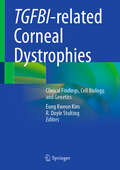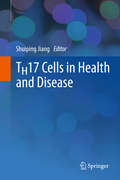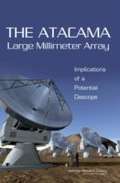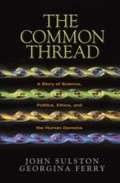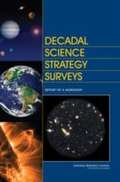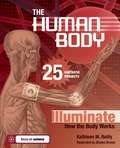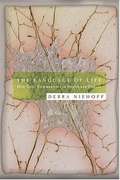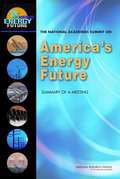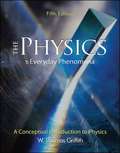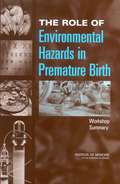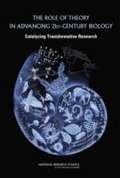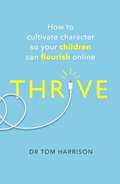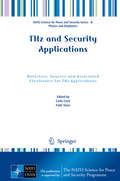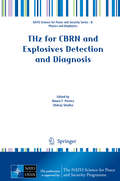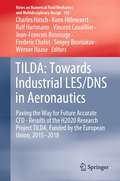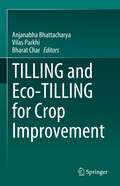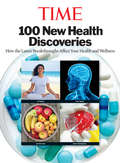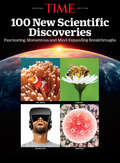- Table View
- List View
TGF-β in Human Disease
by Aristidis Moustakas Keiji MiyazawaTransforming growth factor-β (TGF-β) is a secreted polypeptide with multifunctional properties manifested during embryonic development, adult organ physiology, and pathobiology of major diseases, including cancer and fibrotic and cardiovascular diseases. The signaling pathway of TGF-β now is rather well understood. Continuing revelations in the mechanisms of action of TGF-β provide specific mechanistic examples of how human cells lose their controlled function and behave wrongly during the development of diverse diseases. Equally important, however, is the current promise of exploiting the TGF-β pathway in combating human disease. This book comprehensively covers major areas of human disease where the involvement of TGF-β is firmly established. Simultaneously, the book highlights major gaps in knowledge and the future directions of research that can benefit human medical science. The core set of diseases where TGF-β action is well documented and are included in the book are cancer and cardiovascular and fibrotic disorders. The central aim of the book is to stimulate young scientists to enter the prolific TGF-β field and find new solutions to the problems remaining in this area of study. For this purpose the book provides authoritative educational chapters that furnish a good introduction to the field for young doctoral students, postdocs, and clinical fellows. The book also serves as a valuable reference for the aficionados in the field, who can find accessible and well-illustrated material for their teaching and lecturing activities, via which the importance of TGF-β biology is disseminated to the world of science and to the public.
TGFBI-related Corneal Dystrophies: Clinical Findings, Cell Biology, and Genetics
by Eung Kweon Kim R. Doyle StultingThis book provides up-to-date information about the basic cell biology, protein processing mechanisms, genetics, and treatment strategies for TGFBI-related corneal dystrophies. Extensive illustrations document the clinical appearance of these dystrophies, and details of their cell biology provide our current understanding of intracellular pathologic mechanisms related to the mutated TGFBI protein. Descriptions of metabolic pathways involving TGFBI protein include recent information about the intracellular processing of normal and mutated TGFBI proteins. Detailed descriptions of the pathologic basis for TGFBI-related corneal dystrophies and possible strategies for human gene therapy are provided. This book offers a rich source of information about the pathogenesis, diagnosis, and treatment options for practicing ophthalmologists, specialists, and trainees.
TH17 Cells in Health and Disease
by Shuiping Jiang"About 25 years ago, Mosmann & Coffman introduced the TH1 / TH2 paradigm of T helper cell differentiation which helped explain many aspects of adaptive immunity from eliminating intracellular versus extracellular pathogens to induction of different types of tissue inflammation. However, TH1 / TH2 paradigm could not adequately explain development of certain inflammatory responses which provided impetus for the discovery of a new subset of T cells called TH17 cells. After the discovery of differentiation and transcription factors for TH17 cells, it was clear that TH17 cells represent an independent subset of T cells with specific functions in eliminating certain extracellular pathogens, presumably not adequately handled by TH1 or TH2 cells. The major role of TH17 cells has been described in inducing auto-immune tissue inflammation. The discovery of TH17 cells has expanded the TH1 / TH2 paradigm, and the integration of TH17 cells with TH1 and TH2 effector T cells is beginning to explain the underlying mechanisms of tissue inflammation in a number of infections and auto-immune disease settings." - From Chapter One by Vijay K. Kuchroo, Harvard University, USA "The recently identified Interleukin 17 (IL-17) cytokine family contributes to immunity to infectious diseases and chronic inflammatory diseases. Further studies on the regulation and function of this important cytokine family may provide better understanding on the roles of the IL-17 family in immune-mediated diseases; such knowledge may lead to the development of immunotherapeutic strategies for treatment of several inflammatory diseases." - From Chapter Two by Chen Dong, University of Texas and MD Anderson Cancer Center, USA
THE ATACAMA Large Millimeter Array: Implications of a Potential Descope
by National Research Council of the National AcademiesThe 1991 NRC decadal survey for astronomy and astrophysics included a project called the Millimeter Array (MMA). This instrument would be an array of millimeter-wavelength telescopes intended to capture images of star-forming regions and distant star-burst galaxies. With the addition of contributions form Europe, the MMA evolved into the Atacama Large Millimeter Array (ALMA), a proposed array of 64, 12-meter antennas. The project is now part of the NSF Major Research Equipment and Facilities budget request. Increased costs, however, have forced the NSF to reconsider the number of antennas. To help with that review, NSF asked the NRC to assess the scientific consequences of reducing the number of active antennas from 60 to either 50 or 40. This report presents an assessment of the effect of downsizing on technical performance specifications, performance degradation, and the ability to perform transformational science, and of the minimum number of antennas needed.
THE COMMON THREAD: A Story of Science, Politics, Ethics, and the Human Genome
by John Sulston Georgina FerryThe world was agog when scientists made the astounding announcement that they had successfully sequenced the human genome. Few contributed so directly to this feat as John Sulston. This is his personal account of one of the largest international scientific operations ever undertaken.It was a momentous occasion when British scientist John Sulston embarked on the greatest scientific endeavor of our times: the sequencing of the Human Genome. In The Common Thread, Sulston takes us behind the scenes for an in-depth look at the controversial story behind the headlines. The accomplishments and the setbacks—along with the politics, personalities, and ethics—that shaped the research are frankly explored by a central figure key to the project.From the beginning, Sulston fervently proclaimed his belief in the free and open exchange of the scientific information that would emerge from the project. Guided by these principles, The Human Genome Project was structured so that all the findings were public, encouraging an unparalleled international collaboration among scientists and researchers.Then, in May 1998, Craig Venter announced that he was quitting the Human Genome Project—with plans to head up a commercial venture launched to bring out the complete sequence three years hence, but marketed in a proprietary database. Venter’s intentions, clearly anathema to Sulston and the global network of scientists working on the Project, marked the beginning of a dramatic struggle to keep the human genome in the public domain.More than the story of human health versus corporate wealth, this is an exploration of the very nature of a scientific quest for discovery. Infused with Sulston’s own enthusiasm and excitement, the tale unfolds to reveal the scientists who painstakingly turn the key that will unlock the riddle of the human genome. We are privy to the joy and exuberance of success as well as the stark disappointments posed by inevitable failures. It is truly a wild and wonderful ride.The Common Thread is at once a compelling history and an impassioned call for ethical responsibility in scientific research. As the boundaries between science and big business increasingly blur, and researchers race to patent medical discoveries, the international community needs to find a common protocol for the protection of the wider human interest. This extraordinary enterprise is a glimpse of our shared human heritage, offering hope for future research and a fresh outlook on our understanding of ourselves.
THE DEVELOPMENT OF SCIENCE-BASED GUIDELINES FOR LABORATORY ANIMAL CARE: Proceedings of the November 2003 International Workshop
by Institute for Laboratory Animal ResearchInformation into THE DEVELOPMENT OF SCIENCE-BASED GUIDELINES FOR LABORATORY ANIMAL CARE
THE FUTURE OF U.S. Chemistry Research: BENCHMARKS AND CHALLENGES
by National Research Council of the National AcademiesChemistry plays a key role in conquering diseases, solving energy problems, addressing environmental problems, providing the discoveries that lead to new industries, and developing new materials and technologies for national defense and homeland security. However, the field is currently facing a crucial time of change and is struggling to position itself to meet the needs of the future as it expands beyond its traditional core toward areas related to biology, materials science, and nanotechnology. At the request of the National Science Foundation and the U.S. Department of Energy, the National Research Council conducted an in-depth benchmarking analysis to gauge the current standing of the U.S. chemistry field in the world. The Future of U.S. Chemistry Research: Benchmarks and Challenges highlights the main findings of the benchmarking exercise.
THE HUMAN BODY
by Shawn Braley Kathleen M. ReillyKids will be amazed at all the action that's going on right inside their own bodies, from understanding just how that apple turns into energy to how the "leftovers" make their exit. The Human Body: 25 Fantastic Projects Illuminate How the Body Works will engage kids with hands-on activities that will show them all the fantastic, well-orchestrated systems at work in their very own bodies-they'll see exactly how smoke affects the lung, how the heart really acts as a liquid pump, and how the different joints are structured and serve different purposes. Kids will gain a concrete understanding of their bodies-and realize in the process just how amazing they really are.
THE LANGUAGE OF LIFE: How Cells Communicate in Health and Disease
by Debra NiehoffCooperation requires conversation. Human beings speak to one another. Sounds, scents, and postures allow animals to make their point. While individual cells can't talk, hiss, growl, or bare their teeth, they nevertheless communicate regularly. Their language is based not on words or gestures, but on chemistry--using molecules where we would use words, constructing sentences from chains of proteins. The cells that make up the bodies of muticellular organisms inform, wheedle, command, exhort, reassure, nurture, criticize, and instruct each other to direct every physiological function, report every newsworthy event, record every memory, heal every wound. And each of those chemical conversations represents an opportunity for scientists and physicians. The molecular biologists who worked for over a decade to sequence the human genome have sometimes referred to that sequence as the "book of life. " To our cells, that "book" is no more than a dictionary--only living cells can converse, forming the network that allows our 60 trillion cells to function as a single organism. For nearly a century, researchers have been straining to hear the whispered conversations among cells, hoping to master the basics of their language. They know that if we can decipher and translate this cellular chatter, we have the potential for sending signals of our own that could repair wounds, reduce cholesterol, control insulin levels, or even block the reproduction of cancer cells. The possibilities are as endless as they are intriguing. The Language of Life is a fantastic story of discovery, blending the vision of science with the poetry of life itself.
THE NATIONAL ACADEMIES SUMMIT ON America's Energy Future: SUMMARY OF A MEETING
by National Research Council of the National AcademiesThere is a growing sense of national urgency about the role of energy in long-term U.S. economic vitality, national security, and climate change. This urgency is the consequence of many factors, including the rising global demand for energy; the need for long-term security of energy supplies, especially oil; growing global concerns about carbon dioxide emissions; and many other factors affected to a great degree by government policies both here and abroad. On March 13, 2008, the National Academies brought together many of the most knowledgeable and influential people working on energy issues today to discuss how we can meet the need for energy without irreparably damaging Earth's environment or compromising U.S. economic and national security-a complex problem that will require technological and social changes that have few parallels in human history. The National Academies Summit on America's Energy Future: Summary of a Meeting chronicles that 2-day summit and serves as a current and far-reaching foundation for examining energy policy. The summit is part of the ongoing project 'America's Energy Future: Technology Opportunities, Risks, and Tradeoffs,' which will produce a series of reports providing authoritative estimates and analysis of the current and future supply of and demand for energy; new and existing technologies to meet those demands; their associated impacts; and their projected costs. The National Academies Summit on America's Energy Future: Summary of a Meeting is an essential base for anyone with an interest in strategic, tactical, and policy issues. Federal and state policy makers will find this book invaluable, as will industry leaders, investors, and others willing to convert concern into action to solve the energy problem.
THE ROLE OF Environmental Hazards in Premature Birth: Workshop Summary
by Medicine Research Roundtable on Environmental Health SciencesEach year in the United States approximately 440,000 babies are born premature. These infants are at greater risk of death, and are more likely to suffer lifelong medical complications than full-term infants. Clinicians and researchers have made vast improvements in treating preterm birth; however, little success has been attained in understanding and preventing preterm birth. Understanding the complexity of interactions underlying preterm birth will be needed if further gains in outcomes are expected. The Institute of Medicine’s Roundtable on Environmental Health Sciences, Research, and Medicine sponsored a workshop to understand the biological mechanism of normal labor and delivery, and how environmental influences, as broadly defined, can interact with the processes of normal pregnancy to result in preterm birth. This report is a summary of the main themes presented by the speakers and participants.
THE ROLE OF THEORY IN ADVANCING 21ST-CENTURY BIOLOGY: Catalyzing Transformative Research
by National Research Council of the National AcademiesAlthough its importance is not always recognized, theory is an integral part of all biological research. Biologists' theoretical and conceptual frameworks inform every step of their research, affecting what experiments they do, what techniques and technologies they develop and use, and how they interpret their data. By examining how theory can help biologists answer questions like "What are the engineering principles of life?" or "How do cells really work?" the report shows how theory synthesizes biological knowledge from the molecular level to the level of whole ecosystems. The book concludes that theory is already an inextricable thread running throughout the practice of biology; but that explicitly giving theory equal status with other components of biological research could help catalyze transformative research that will lead to creative, dynamic, and innovative advances in our understanding of life.
THE SILENT LANDSCAPE: The Scientific Voyage of HMS Challenger
by Richard CorfieldIn 1872 HMS Challenger set sail from Portsmouth, England, to map and sample the ocean floor. This marked the birth of modern oceanography. By retracing Challenger’s extraordinary voyage, we view our underwater landscape anew – focusing on what 21st century science is now able to add to this incredible story. The oceans make up more than two thirds of the Earth’s surface. But they are as mysterious for what they conceal beneath their surfaces as they are familiar for their ubiquity. Deep below the susurrus swell of waves lies an alien world that we have only begun to explore. The quest to know more about this secret domain began in earnest in the late 1800s. In 1859, Charles Darwin’s book On the Origin of Species by Means of Natural Selection set the scientific world abuzz with its radical theory of evolution, and sparked a feverish desire to know more about the workings of nature. Scientists became increasingly convinced that the ocean floor could provide proof – or refutation – of Darwin’s theory of natural selection. They believed that the ocean floor was a haven for life that had long been extinct on land and that obscure fossil evidence culled from the depths could provide us with information on species that no longer existed topside. So an expedition was specifically designed and undertaken to investigate the natural history and geology of the ocean floor. With its emphasis on locating and retrieving fossil records that would test the new theory of evolution, Challenger’s voyage was nothing less than a mission to choose between God and science. Sailing three and half years and 69,000 nautical miles through burning tropical heat waves and stupefyingly cold Antarctic seas, and suffering further privations of hunger, storms, and sometimes crushing boredom between data-collecting surveys, Challenger dredged up thousands of samples from the sea floor and mapped enormous areas of undersea terrain. The final result was nothing short of a roaring success. So extensive were their findings that it was to take the scientists 19 years to completely examine and report on all their data. The final report, published in 1895, ran to fifty volumes. Most startling of all was the revelation that the ocean was not a silent landscape that serenely reflected Earth’s past – it was a gloriously vibrant ecosystem teeming with a variety and multitude of life on a scale we could scarcely imagine from our landlocked perspective. Relying on the official documentation, logs, and journals of the ship’s company, The Silent Landscape recounts the tale of an extraordinary voyage brought to life by 21st-century science. From the endangered coral reefs of the Caribbean to the trackless depths beneath the western Pacific, The Silent Landscape takes us on an epic journey across time.
THRIVE: How to Cultivate Character So Your Children Can Flourish Online
by Dr Tom HarrisonWinner of the International Federation for Family Development Award.When Dr Tom Harrison, a leading expert in the field of character education and the Internet, bought his daughter her first smartphone, a major milestone had been reached: she had entered the 'cyber-world'. Harrison no longer needed to know what to think; he needed to know what to do. This is the first practical book of its kind to show parents and teachers how to develop character as the foundation for helping young people to thrive in their online interactions. It answers the question: How do we prepare our children to do the right thing when no one is watching?Based on his own experience as a parent, more than a decade of research and thousands of conversations with parents, teachers, children and policymakers, the REACT and THRIVE models have been developed to engage with character, wellbeing, social and emotional learning, ethics and digital citizenship - all the ingredients for flourishing online.The world is waking up to the importance of character for individual and wider societal flourishing. Harrison is at the forefront of this movement and is regularly invited to advise policymakers and thousand of teachers and parents around the world. This book is a must-read for parents and educators who want to help children not just survive but thrive online in their cyber-worlds.
THRIVE: How to Cultivate Character So Your Children Can Flourish Online
by Dr Tom HarrisonWinner of the International Federation for Family Development Award.When Dr Tom Harrison, a leading expert in the field of character education and the Internet, bought his daughter her first smartphone, a major milestone had been reached: she had entered the 'cyber-world'. Harrison no longer needed to know what to think; he needed to know what to do. This is the first practical book of its kind to show parents and teachers how to develop character as the foundation for helping young people to thrive in their online interactions. It answers the question: How do we prepare our children to do the right thing when no one is watching?Based on his own experience as a parent, more than a decade of research and thousands of conversations with parents, teachers, children and policymakers, the REACT and THRIVE models have been developed to engage with character, wellbeing, social and emotional learning, ethics and digital citizenship - all the ingredients for flourishing online.The world is waking up to the importance of character for individual and wider societal flourishing. Harrison is at the forefront of this movement and is regularly invited to advise policymakers and thousand of teachers and parents around the world. This book is a must-read for parents and educators who want to help children not just survive but thrive online in their cyber-worlds.
THz Communications: Paving the Way Towards Wireless Tbps (Springer Series in Optical Sciences #234)
by Tadao Nagatsuma Thomas Kürner Daniel M. MittlemanThis book describes the fundamentals of THz communications, spanning the whole range of applications, propagation and channel models, RF transceiver technology, antennas, baseband techniques, and networking interfaces. The requested data rate in wireless communications will soon reach from 100 Gbit/s up to 1 Tbps necessitating systems with ultra-high bandwidths of several 10s of GHz which are available only above 200 GHz. In the last decade, research at these frequency bands has made significant progress, enabling mature experimental demonstrations of so-called THz communications, which are thus expected to play a vital role in future wireless networks. In addition to chapters by leading experts on the theory, modeling, and implementation of THz communication technology, the book also features the latest experimental results and addresses standardization and regulatory aspects. This book will be of interest to both academic researchers and engineers in the telecommunications industry.
THz and Security Applications
by Carlo Corsi Fedir SizovThese proceedings comprise invited papers from highly experienced researchers in THz technology and security applications. THz detection of explosives represents one of the most appealing technologies to have recently emerged in dealing with terrorist attacks encountered by civil security and military forces throughout the world. Discussed are the most advanced technologies and developments, the various points of operational strength and weaknesses as well as are suggestions and predictions the best technological solutions to overcome current operational limits The current status of various levels of cooling in THz detectors, sources and associated electronics are also addressed. The goal was to provide a clear view on the current technologies available and the required advances needed in order to achieve more efficient systems. This goal was outlined in part by establishing the baseline of current uncertainty estimations in physics-based modelling and the identification of key areas which require additional research and development.
THz for CBRN and Explosives Detection and Diagnosis
by Oleksiy Shulika Mauro F. PereiraThis work is intended to jointly address the development, realization and applications of emitters and detectors of terahertz (THz-0. 3 THz up to 10 THz) and their application to diagnostics of CBRN effects and detection of explosives and CBRN. Hazardous substances typically exhibit rotational and vibrational transitions in this region, hence giving access to spectroscopic analysis of a large variety of molecules which play a key role in security as well as various other areas, e. g. air pollution, climate research, industrial process control, agriculture, food industry, workplace safety and medical diagnostics can be monitored by sensing and identifying them via THz (0. 3 to 10 THz) and mid infrared (MIR-10 THz to 100 THz) absorption "finger prints". Most plastics, textiles and paper are nearly transparent for THz radiation.
TIGER – Kommunikationskonzept Tiefe Geothermie (essentials)
by Anna Borg Mathias Jürgen BauerDas vorliegende Kommunikationskonzept unterst#65533;tzt Investoren, Betreiber und Institutionen bei der #65533;ffentlichkeitsarbeit und Kommunikation f#65533;r den Bereich Tiefe Geothermie und zeigt Wege auf, die Akzeptanz f#65533;r das lokale Projekt zu f#65533;rdern. Es geht auf den Auftrag des durch das Bundesministerium f#65533;r Wirtschaft und Energie (BMWi) gef#65533;rderten Forschungsprojektes ,,TIGER - Tiefe Geothermie: Akzeptanz und Kommunikation einer innovativen Technologie" zur#65533;ck.
TILDA: Paving the Way for Future Accurate CFD - Results of the H2020 Research Project TILDA, Funded by the European Union, 2015 -2018 (Notes on Numerical Fluid Mechanics and Multidisciplinary Design #148)
by Charles Hirsch Werner Haase Vincent Couaillier Koen Hillewaert Ralf Hartmann Jean-Francois Boussuge Frederic Chalot Sergey BosniakovThis book offers detailed insights into new methods for high-fidelity CFD, and their industrially relevant applications in aeronautics. It reports on the H2020 TILDA project, funded by the European Union in 2015-2018. The respective chapters demonstrate the potential of high-order methods for enabling more accurate predictions of non-linear, unsteady flows, ensuring enhanced reliability in CFD predictions. The book highlights industrially relevant findings and representative test cases on the development of high-order methods for unsteady turbulence simulations on unstructured grids; on the development of the LES/DNS methodology by means of multilevel, adaptive, fractal and similar approaches for applications on unstructured grids; and on leveraging existent large-scale HPC networks to facilitate the industrial applications of LES/DNS in daily practice. Furthermore, the book discusses multidisciplinary applications of high-order methods in the area of aero-acoustics. All in all, it offers timely insights into the application and performance of high-order methods for CFD, and an extensive reference guide for researchers, graduate students, and industrial engineers whose work involves CFD and turbulence modeling.
TILLING and Eco-TILLING for Crop Improvement
by Anjanabha Bhattacharya Vilas Parkhi Bharat CharThis edited book is a comprehensive compilation of deliberations in the field of agriculture, food security, climate resilient crops and on the relevance of the popular TILLING technique in the era of precise genome editing (CRISPR/Cas9). This book particularly deliberates on new developments in this field, such as, induced mutagenesis techniques, mutagenesis in somatic tissues, bio-informatics analysis and gene mining. This volume also focuses on next generation mutation detection techniques, exome capture, forward and reverses genetics, trait selection and, finally deliberates on the future of TILLING in plant breeding and product development. TILLING (Targeting Induced Local Lesions in Genome) is a popular molecular biology technique for detecting polymorphism in a mutagenized population. Eco-TILLING refers to natural TILLING. This technique can be applied to a wider range of crops. Products developed through TILLING are not regulated throughout the world, thus having a wider acceptance among various stakeholders. This volume is timely and looks into the updated aspects of mutagenesis, TILLING, Eco-TILLING along with OMIC tools, their amalgamated applications towards crop improvement. This book contains 11 chapters and 250 pages authored by globally reputed scientists on the field of mutagenesis, TILLING and Eco-TILLING. This book is useful for research scholars, students, teachers and scientists in the academia, policy makers, relevant public, plant breeding companies, private companies and cooperatives interested in understanding or applying mutagenesis, TILLING for editing gene of interest and develop new products in agriculture.
TIM: Defender of the Earth
by Sam EnthovenTIM (that's Tyrannosaur: Improved Model), is the product of a top-secret military experiment, and up to now he's been living in a comfy lab beneath London's Trafalgar Square. But his world is about to change. Humanity is facing the greatest threat it has ever known: the brilliant, demented Professor Mallahide and his growing swarm of vicious nanobots. Tim must form an unlikely alliance with fourteen-year-old Chris and his classmate Anna-Professor Mallahide's daughter-to prevent our whole planet from becoming one seething tide of machines. The stage is set for the smackdown of the century. Who will prevail-the awesome, all-consuming Mallahide and his swarm? or TIM, DEFENDER OF THE EARTH!
TIME 100 New Health Discoveries: How the Latest Breakthroughs Affect Your Health and Wellness
by Editors of TIMEScientists and doctors are always working to unlock the secrets of the human body, bringing a stream of new scientific discoveries that can help us live longer, happier, healthier lives. In this special edition, TIME presents 100 of the most useful breakthroughs of the past year, discoveries that will help you eat better, exercise more effectively, prevent disease more easily and sleep more soundly. Among the highlights: The big data in our bodies: new devices are enabling users to quantify their inner chemistry, but what can they do with the info? Statins as a wonder drug: they are so effective at lowering heart disease that some experts believe more people should be taking them. Unlocking women's sex drive: new drugs are being developed to help stoke female sexual desire.
TIME 100 New Scientific Discoveries: Fascinating, Momentous and Mind-Expanding Breakthroughs
by The Editors of TIMEIn the latest of TIME's extraordinary volumes on scientific discoveries, this special edition curates the 100 most impactful recent breakthroughs across 10 disciplines. Through sharp photos and TIME's peerless reporting, readers will explore the most captivating news and revelations in technology, botany, archaeology, genetics, zoology, the Earth, the mind, the cosmos, medicine and chemistry. Among the highlights: How to curb Alzheimer's disease with small lifestyle changes, Controversial findings about newfound human ancestors known as the Hobbits, High-tech solutions to diabetes care, The gene-editing technique known as CRISPR, and the ethical questions behind it, Why the plight of the honeybee matters.

